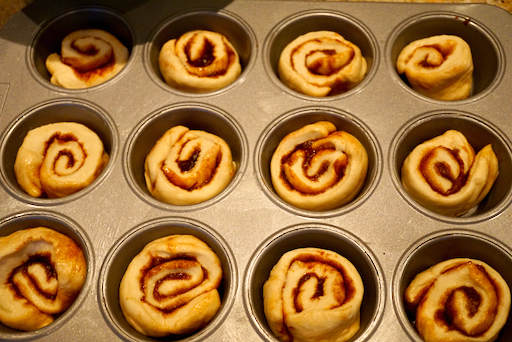The picture below shows two breads my wife made for Easter and served on her favorite Easter bunny plate. The one on the right is a hot cross bun that she made before the yeast shortage so it was not made using biga. It didn't have a frosting cross on top instead my wife cut the baked bun in half and put the cream cheese icing used for the cross inside. The bun on the left is a cheese bun made with biga.
Here are the cross sections. The cheese roll has, of course, cheese stuffing that was baked in the bun. The hot cross bun lost the cross but the icing was sandwiched in the muffin after the muffin was baked.
Ingredients:
Biga: (Hers has more liquid than traditional biga. So, this is a cross between biga and poolish)
1 3/4 cups flour
2 cups buttermilk
1/8 tsp yeast
Dough:
biga
3 tbs sugar
2 tsp salt
3 tbs butter
2 1/4 cups flour as needed (to make a total of 4 cups including flour in the biga)
1/8 additional yeast (optional) it will result in a quicker rise.
Cheese filling
4 oz. feta cheese crumbled
5 oz. ricotta cheese
2 oz. smoked gouda, grated
2 oz. monterey jack, grated
2 oz. double Gloucester, grated (other cheeses could be substituted such as smoked mozzarella)
1 egg
sprinkle of red pepper flakes (to taste)
Day 1: in the evening mix together the ingredients for the biga (#1) cover the bowel with plastic wrap and several towels and leave out overnight. Picture (#2) shows what it looks like next morning.
Day 2: Make the cheese filling by adding the cheese ingredients together and mixing until blended then set aside (#1). Make the dough using the biga and dough ingredients. Let rise in a covered bowel (#2). (The rise will be very slow. I made the dough at 8:00 AM and formed the rolls at 4:00 PM). After the first rise punch the dough down. Cut into 2 1/4 oz. pieces. Using a small ice cream scoop put a scoop of cheese in the middle of the dough (#3) and using the dough cover the cheese (#4). Put the muffin into a heavily greased large pyrex baking dish and let rise again (#5). (This rise will go much faster). Bake at 400 degrees for 20 to 25 minutes until golden (#6). Remove immediately to let cool. As the picture shows some of the filling leaked out as the muffins cooked but plenty was still left inside.
These muffins were not as fluffy as the same recipe made with commercial yeast but the flavor was just incredible; very rich with depth. The texture is also a bit more chewy but still a wonderful mouth feel. These buns were made with much less yeast. The original recipe made with commercial yeast would have used 4 1/2 tsp yeast while this recipe used a maximum of 1/4 tsp yeast. The thing we noticed was that as the dough was rising it gave off a pleasant strong yeasty smell that was wonderful and not something we noticed when we made the muffins using commercial yeast. Also, the smell while the buns were cooking in the oven was stronger than usual adding to one of the basic pleasures of making bread; the smell as it cooks. The combination of the flavor of the dough with the cheese filling was really wonderful. We couldn't get enough of it. So although the use of biga was born of necessity (a shortage of yeast during the corona-19 outbreak) it has opened up a whole new dimension of bread making that we would not have tried otherwise. Once having tasted the wonderful flavor of this bread we will be using biga as much as possible.

















































